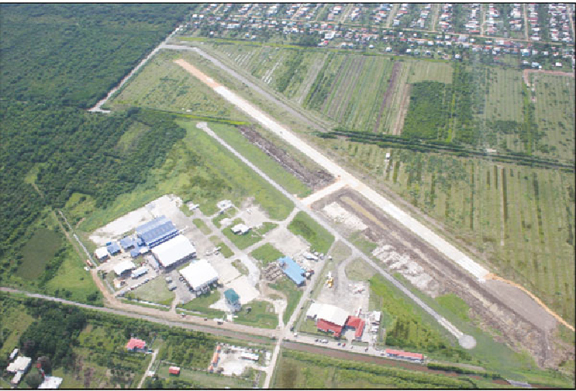Ogle International Airport is a general aviation Regional Class Airport with a Class2C runway catering to commercial and private operators of aircraft. It is located 7miles (11 km) by road to the east of the centre of Georgetown and approximately 0.5miles (800 m) outside the municipal boundaries.
The Airport is situated in the peri-urban district of Ogle and occupies 441 acres (or 178 h) of land. It is 24 miles (37 km) north-northeast of Cheddi Jagan International Airport at Timerhi.

The Airport has been in operation since the 1950s. Initially, the Airport was as a light aircraft strip constructed to service the sugar industry of Guyana mainly for crop dusting. Ogle Airport has therefore been in continuous operation for nearly fifty years.
In the 1960’s and 1970’s the Aerodrome was also utilized domestically by Guyana Airways Corporation and for support services to the Rice, Timber and Gold and Diamond Mining Industries. The Private Sector Airlines subsequently evolved into the provision of charter services and scheduled passenger services to Guyana’s hinterland.
Over the years, Ogle has developed into the main domestic hub providing commercial passenger and cargo air transport services, primarily between Georgetown and the hinterland of Guyana. The Airport is still used for Guyana Sugar Corporation (Guysuco) crop dusting operations at all Guysuco sugar plantations.
The Airport serves as the base of operations now of some 13 operators maintaining a fleet in excess of 44 aircraft transporting approximately 80,000 passengers and 5,000 tons of cargo a year, and representing an investment of about $3 billion in fixed assets, aircraft and equipment.
As a result of the International Civil Aviation Organization (ICAO) audits in 1993 and 1995, the Ogle Airport was found to be unsafe for aircraft operations according to ICAO standards. In 1995, the Government of Guyana (GOG) approved the UNDP/ICAO Preliminary Master Plan for Timehri International and Ogle Regional Airport adoption.
Since the GOG did not want to close Ogle Airport it decided to investigate the possibility of privatizing the Airport. It undertook through the Inter-American Development Bank (IDB) a feasibility study to determine the financial viability of privatizing Ogle Airport as an option. The result of that study, the Norconsult Report, demonstrated Ogle Airport’s financial feasibility as an international Port-of-Entry using an 4,000ft class 2 (C) runway serving domestic and regional international destinations.
Privatising the airport
The GOG took a decision, therefore, to proceed with the option of developing Ogle to ICAO standards by privatizing the Airport. On November 5, 2001, a 25 year Lease Agreement for the management, operation and development of Ogle Airport, extendable for a further period of up to two periods of 25 years, was signed between the GOG and Ogle Airport Inc. (OAI).

The Lease Agreement incorporated mandatory improvements under a Phase I Project to construct a new 800-metre runway designed to ICAO specifications, associated taxiways, aprons and ramps and appropriate terminal facilities, including a new control tower.
OAI is a company incorporated by a group of local airline operators who had formed the Aircraft Owners Association of Guyana (AOAG). OAI assumed management of the airport on December 1, 2001.
The Ogle Airport Development project was therefore an upgrade of Ogle Airport, focused primarily on meeting ICAO requirements involving a private investment of approximately US$3M and bringing the Ogle Airport to Port-of-Entry status.
The Airport gained its International Airport status in 2009 after the completion of its Phase I development. International scheduled passenger operations commenced from that date.
In the same year, the GOG and OAI signed a Memorandum of Understanding (MOU) for the funding of the Phase II development of the Airport with funding from a 2007 EU grant of 1.5M Euros for the extension of the runway to 4,000 X 100 feet to an ICAO Class 2C runway to meet the requirements of carriers like LIAT and CAL.
The Airport is about to complete its Phase II construction. This Phase will provide for a longer wider runway capable of accepting aircraft in the turbo prop class such as Dash 8, series 300 aircraft operated by LIAT and ATR series operated by Caribbean Airlines Ltd.
The airport is providing better CFR Emergency service, a GPS approach and eventually a VOR/DME new telecommunications, enhanced security and night lighting.
Terminal enhancements are also provided to accommodate up to 100 passengers at any one time and International standards of Airport Safety and Security.
The Airport will be receiving its Phase II Runway Class 2C Certification from the GCAA on the 26 March, 2013.
In the next five years, OAI predicts that the number of aircraft movements will increase by 50%. The projection is for 125,000 aircraft movements per year for the Phase II project. There will be a proportional increase in cargo uplifted to over 2700 tons per annum. In addition, the hours of operations will be extended to 16 hours per day, to accommodate evening traffic.





